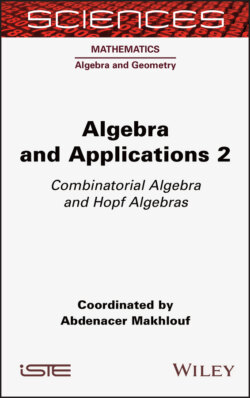Читать книгу Algebra and Applications 2 - Группа авторов - Страница 23
1.3.5. Characters
ОглавлениеLet ℋ be a connected filtered Hopf algebra over k, and let A be a k-algebra. We will consider unital algebra morphisms from ℋ to the target algebra . When the algebra is commutative, we will call them, slightly abusively, characters. We recover, of course, the usual notion of character when the algebra is the ground field k.
The notion of character involves only the algebra structure of ℋ. On the contrary, the convolution product on involves only the coalgebra structure on ℋ. Let us now consider the full Hopf algebra structure on ℋ and see what happens to algebra morphisms with the convolution product:
PROPOSITION 1.10.– Let ℋ be any Hopf algebra over k, and let be a commutative k-algebra. Then, the characters from ℋ to form a group under the convolution product, and for any , the inverse is given by:
[1.26]
PROOF.– Using the fact that Δ is an algebra morphism, we have for any x, y ∈ ℋ:
If is commutative and if f and g are characters, we get:
The unit is an algebra morphism. The formula for the inverse of a character comes easily from the commutativity of the following diagram:
We call infinitesimal characters with values in the algebra those elements α of , such that:
PROPOSITION 1.11.– Let ℋ be a connected filtered Hopf algebra, and suppose that is a commutative algebra. Let (respectively ) be the set of characters of ℋ with values in (respectively the set of infinitesimal characters of ℋ with values in ). Then, is a subgroup of G, the exponential restricts to a bijection from onto , and is a Lie subalgebra of .
PROOF.– Take two infinitesimal characters α and β with values in and compute:
Using the commutativity of , we immediately get:
which shows that is a Lie algebra. Now, for , we have:
as easily seen by induction on n. A straightforward computation then yields:
with
The series above makes sense thanks to connectedness, as explained in section 1.3.4. Now let , and let . Set φ*t := exp(t log φ) for t ∈ k. It coincides with the nth convolution power of φ for any integer n. Hence, φ*t is an -valued character of ℋ for any t ∈ k. Indeed, for any x, y ∈ ℋ, the expression φ*t(xy) – φ*t(x)φ*t(y) is polynomial in t and vanishes on all integers, and hence, vanishes identically. Differentiating with respect to t at t = 0, we immediately find that log φ is an infinitesimal character. □
